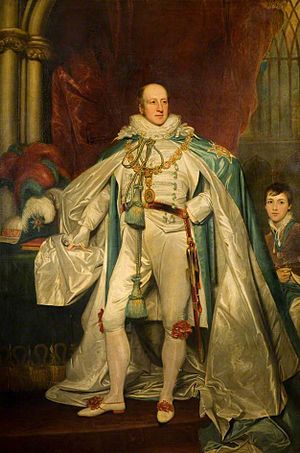Charles Chetwynd-Talbot, 2nd Earl Talbot facts for kids
Quick facts for kids
The Earl Talbot
|
|
|---|---|

Portrait by Thomas Clement Thompson, 1844
|
|
| Lord Lieutenant of Ireland | |
| In office 3 October 1817 – 8 December 1821 |
|
| Monarch | |
| Prime Minister | The Earl of Liverpool |
| Preceded by | The Earl Whitworth |
| Succeeded by | The Marquess Wellesley |
| Personal details | |
| Born | 25 April 1777 |
| Died | 10 January 1849 (aged 71) Ingestre Hall, Staffordshire |
| Nationality | British |
| Spouse | Frances Lambart (d. 1819) |
| Children | 11 |
| Parents | John Chetwynd-Talbot, 1st Earl Talbot Lady Charlotte Hill |
| Alma mater | Christ Church, Oxford |
Charles Chetwynd Chetwynd-Talbot, 2nd Earl Talbot (born April 25, 1777 – died January 10, 1849) was an important British politician. He held the title of Viscount of Ingestre from 1784 to 1793. Later, he became the Lord Lieutenant of Ireland, serving from 1817 to 1821. He was also a Fellow of the Royal Society, which means he was recognized for his contributions to science.
Contents
Early Life and Education
Charles Talbot was born in 1777. He was the oldest son of John Chetwynd-Talbot, 1st Earl Talbot and Lady Charlotte Hill. His father was an important person who owned Ingestre Hall.
In 1784, when Charles was seven, his father was given the new title of Earl Talbot. Charles then became known as Viscount of Ingestre. This was a "courtesy title," meaning he used it because of his father's rank, but he didn't actually hold the full title yet. In 1786, his father added "Chetwynd" to their family name.
Charles inherited his father's earldom and the family estate, Ingestre, in 1793. He went to Christ Church, Oxford University in 1794 and finished his studies in 1797. Around 1810, he hired the famous architect John Nash to update and improve Ingestre Hall.
Public Service and Roles
After university, Lord Talbot worked at the British embassy in Russia. There, he became good friends with his boss, Lord Whitworth.
In 1803, he helped organize a group of volunteers in Staffordshire. Their goal was to prepare for a possible invasion by Napoleon. In 1812, he was chosen to be the Lord Lieutenant of Staffordshire. This was a high-ranking official who represented the King in the county. He held this important job for the rest of his life. In 1813, he became a Fellow of the Royal Society because of his interest in learning and science.
Lord Lieutenant of Ireland
In 1817, Lord Talbot was given an even bigger role: Lord Lieutenant of Ireland. This person was the King's chief representative in Ireland. He also joined the Privy Council, a group of advisors to the King.
He was recognized for helping Irish farming. In 1821, when King George IV visited Ireland, Lord Talbot was made a Knight of St Patrick. This was a special honor.
Even though he was against giving more rights to Catholics, some important Irish leaders, like Daniel O'Connell, respected him for being fair. However, there was growing unhappiness in Ireland during his time. Because of this, the Prime Minister decided to replace him in December 1821.
Later Years and Contributions
In 1833, Lord Talbot was asked to consider becoming the head of Oxford University. However, he decided not to, out of respect for the Duke of Wellington.
In 1839, he received £1400 as a thank you for his work as Lord Lieutenant of Staffordshire. He used this money to help build a new church in Salt, Staffordshire. He supported Robert Peel, a leading politician. In 1844, he became a Knight of the Garter, which is one of the highest honors in Britain. He also supported ending the Corn Laws, which were laws about grain prices. He was one of the first important people to do so.
As a landowner in Staffordshire, Lord Talbot gave land for a church in Hixon in 1846. He also had a public house (a type of pub) rebuilt in Brereton in 1847.
Historical Context of Slavery Compensation
Historically, in the 1830s, the British government ended slavery in its colonies. When this happened, some former slave owners or their families received money as compensation.
Lord Talbot was involved in the process of distributing this money as an executor for someone else's will. This meant he was responsible for managing the money for the beneficiaries of that will. The records show that payments were made for enslaved people on two estates in Jamaica. The total payment was £4,660, which was a large sum of money at the time.
Family Life
Lord Talbot married Frances Thomasine Lambart in 1800. They had eleven children who lived to adulthood:
- Lady Frances Charlotte (1801–1823)
- Charles Thomas (1802–1826)
- Henry John (who later became the 3rd Earl Talbot and 18th Earl of Shrewsbury)
- Arthur (1805–1884), who became a clergyman
- John (1806–1852), a judge
- Lady Cecil Chetwynd (1808–1877)
- (George) Gustavus (1810–1896), who became a clergyman
- William Whitworth (1814–1888), who became a clergyman
- Gilbert Chetwynd (1816–1896), who became a clergyman
- Wellington Patrick Manvers (1817–1898), a soldier
- Gerald (1819–1885)
Lady Talbot passed away in December 1819, shortly after her youngest child was born. Lord Talbot died at his home, Ingestre Hall, in January 1849, when he was 71 years old. His oldest living son, Henry, took over his title. Henry later also inherited another important title, the Earl of Shrewsbury, from a distant relative.

